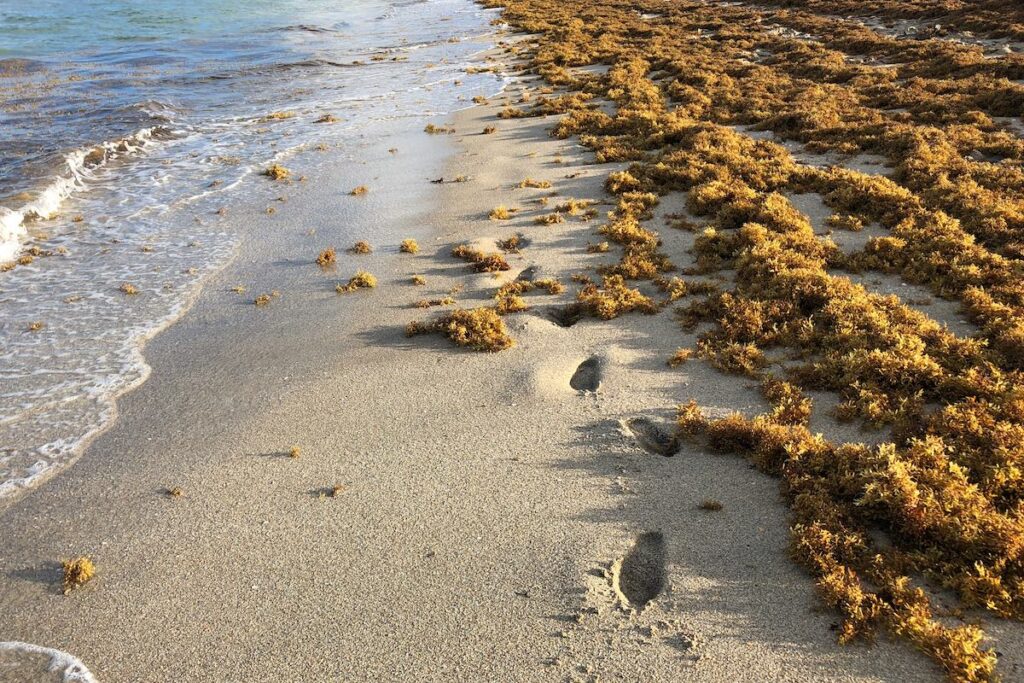No products in the cart.
Travel Guide
Sargassum Seaweed Has Arrived On Florida Beaches And Will Get Worse
Last Updated
For weeks, experts have been warning about giant masses of sargassum coming to Florida, the largest ever seen, and it has already started to hit the coasts.

According to the information shared by Fox 35 Orlando, piles of this seaweed are covering the American coast, and it is not even peak season yet.
Usually, the brown algae begin to appear on shorelines by the end of May or June, but it has come a bit earlier than expected this year.
Travelers visiting the beaches affected by sargassum seaweed are not having the vacation experience they expected, and the situation is already creating problems for locals, tourists, businesses, and the government since the safe removal of seaweed requires large investments.
Experts do not recommend touching the seaweed as it can be home to sea creatures that can produce rashes, and when it rots, it can emit toxic gases.

Florida isn’t alone, as other popular destinations like Cancun in Mexico have also experienced early sargassum seaweed arrival.
Sargassum In Florida
The presence of sargassum seaweed has already been reported on multiple beaches in Florida.
On the East Coast, Cocoa Beach has been one of the most popular beaches now covered with Sargassum seaweed. According to travelers at the beach, it is there in large amounts.
TikTok users have also shared recent videos with proof of the current situation.
Top 5 Travel Insurance Plans For 2023 Starting At $10 Per Week
@blakelodolce Seaweed in cocoa beach #seaweed #seaweedblob #trending #fypシ #cocoabeach #florida #cocoabeachflorida #beachvibes #beachlover #oceanlife #gross #ewww #waves #surf #cops #911calls ♬ original sound – Blake LoDolce
The algae have also reached the west of Florida and arrived at the Gulf Coast beaches.
The account AllThingEmeraldCoast has also shared a video of Pensacola Beach, from just a few days ago, with the text: “Sargassum is starting to show up on Pensacola Beach 4/11/23, this year is the largest bloom in recorded history—I have a feeling it’s about to get a lot worse.”
@allthingsemeraldcoast Yikes! #sargassum #seaweed #seaweedtiktok #pensacolabeach #emeraldcoast #allthingsemeraldcoast #beach #florida ♬ Creepy and simple horror background music(1070744) – howlingindicator
South Beach in Miami also has piles of sargassum across the coast.
The account South Beach Helicopters shared recent aerial views of the seaweed washed up off the coast and beachgoers walking and swimming next to large masses of sargassum.
@southbeachhelicopters Miami is experiencing Sargassum! ????????️???? #miami #sargassum #florida #learnontiktok #learnwithtiktok #fyp #foryou #viral ♬ Spooky, quiet, scary atmosphere piano songs – Skittlegirl Sound
More Seaweed Expected
This is just the beginning of the sargassum seaweed season, and experts predict that once we approach the hot summer months, more algae will be found at the beaches.
Oceanography professor Dr. Chuanmin Hu said: “When we enter the summer months, by end of May or early June, I’d expect more sargassum along the ocean side of the Florida Keys and the east coast of Florida.”
More masses of sargassum seaweed could be coming from the eastern Atlantic. It’s hard to determine exactly how much and when, but local authorities are already taking measures to remove the seaweed from the beaches.

Experts are still researching and trying to understand this phenomenon, as it is getting worse than in previous years.
Is It Dangerous?
This type of macroalgae is usually not dangerous, but it can be under certain circumstances.
When it reaches the shore and rots, after a few days under the sun, it produces hydrogen sulfide, and besides smelling very bad, this gas can cause respiratory problems in some people that are sensitive to it.
This seaweed is also home to certain sea creatures that can produce rashes and blisters on the skin, so it is not advised to touch it.

Another risk is related to wildlife. While in the sea, the sargassum can provide shelter and help certain species breed, large piles of this alga on the coast can also threaten turtle nests in Florida.
And, while many consider a solution to eating these algae and there are multiple tutorials and videos online on how to cook it, experts have warned about the presence of plastic and metals—like arsenic and cadmium in it.
Ed Phlips, an algae researcher at the University of Florida, said that “it picks up all sorts of bacteria and algae and small plants and animals as it moves around.”

Traveler Alert: Don’t Forget Travel Insurance For Your Next Trip!
↓ Join Our Community ↓
The Travel Off Path Community FB group has all the latest reopening news, conversations, and Q&A’s happening daily!

SUBSCRIBE TO OUR LATEST POSTS
Enter your email address to subscribe to Travel Off Path’s latest breaking travel news, straight to your inbox.
This article originally appeared on TravelOffPath.com
Source link

